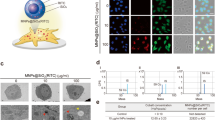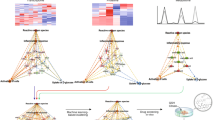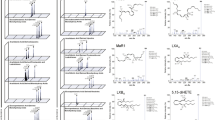Abstract
Nanoparticles have been used in neurological research in recent years because of their blood–brain barrier penetration activity. However, their potential neuronanotoxicity remains a concern. In particular, microglia, which are resident phagocytic cells, are mainly exposed to nanoparticles in the brain. We investigated the changes in lysosomal function in silica-coated magnetic nanoparticles containing rhodamine B isothiocyanate dye [MNPs@SiO2(RITC)]-treated BV2 murine microglial cells. In addition, we analyzed amyloid beta (Aβ) accumulation and molecular changes through the integration of transcriptomics, proteomics, and metabolomics (triple-omics) analyses. Aβ accumulation significantly increased in the 0.1 μg/μl MNPs@SiO2(RITC)-treated BV2 cells compared to the untreated control and 0.01 μg/μl MNPs@SiO2(RITC)-treated BV2 cells. Moreover, the MNPs@SiO2(RITC)-treated BV2 cells showed lysosomal swelling, a dose-dependent reduction in proteolytic activity, and an increase in lysosomal swelling- and autophagy-related protein levels. Moreover, proteasome activity decreased in the MNPs@SiO2(RITC)-treated BV2 cells, followed by a concomitant reduction in intracellular adenosine triphosphate (ATP). By employing triple-omics and a machine learning algorithm, we generated an integrated single molecular network including reactive oxygen species (ROS), autophagy, lysosomal storage disease, and amyloidosis. In silico analysis of the single triple omics network predicted an increase in ROS, suppression of autophagy, and aggravation of lysosomal storage disease and amyloidosis in the MNPs@SiO2(RITC)-treated BV2 cells. Aβ accumulation and lysosomal swelling in the cells were alleviated by co-treatment with glutathione (GSH) and citrate. These findings suggest that MNPs@SiO2(RITC)-induced reduction in lysosomal activity and proteasomes can be recovered by GSH and citrate treatment. These results also highlight the relationship between nanotoxicity and Aβ accumulation.







Similar content being viewed by others
Data availability
Data supporting the findings of this study are available from the corresponding author upon reasonable request. Transcriptome sequencing and quantification data are available in the GEO database under the accession number GSE154250 (Shin et al. 2021b, c). Proteome and quantification data are available in PRIDE with the following accession number: PXD020225 (Shin et al. 2021c).
References
Auffan M, Rose J, Bottero JY, Lowry GV, Jolivet JP, Wiesner MR (2009) Towards a definition of inorganic nanoparticles from an environmental, health and safety perspective. Nat Nanotechnol 4(10):634–641. https://doi.org/10.1038/nnano.2009.242
Baginsky S, Hennig L, Zimmermann P, Gruissem W (2010) Gene expression analysis, proteomics, and network discovery. Plant Physiol 152(2):402–410. https://doi.org/10.1104/pp.109.150433
Beck GR Jr, Ha SW, Camalier CE et al (2012) Bioactive silica-based nanoparticles stimulate bone-forming osteoblasts, suppress bone-resorbing osteoclasts, and enhance bone mineral density in vivo. Nanomedicine 8(6):793–803. https://doi.org/10.1016/j.nano.2011.11.003
Block ML, Zecca L, Hong J-S (2007) Microglia-mediated neurotoxicity: uncovering the molecular mechanisms. Nat Rev Neurosci 8(1):57–69. https://doi.org/10.1038/nrn2038
Bo Y, Jin C, Liu Y, Yu W, Kang H (2014) Metabolomic analysis on the toxicological effects of TiO(2) nanoparticles in mouse fibroblast cells: from the perspective of perturbations in amino acid metabolism. Toxicol Mech Methods 24(7):461–469. https://doi.org/10.3109/15376516.2014.939321
Chakkarapani SK, Shin TH, Lee S, Park KS, Lee G, Kang SH (2021) Quantifying intracellular trafficking of silica-coated magnetic nanoparticles in live single cells by site-specific direct stochastic optical reconstruction microscopy. J Nanobiotechnol 19(1):398. https://doi.org/10.1186/s12951-021-01147-1
Chen R, Huo L, Shi X et al (2014) Endoplasmic reticulum stress induced by zinc oxide nanoparticles is an earlier biomarker for nanotoxicological evaluation. ACS Nano 8(3):2562–2574. https://doi.org/10.1021/nn406184r
Cheng Y, Tian DY, Wang YJ (2020) Peripheral clearance of brain-derived Abeta in Alzheimer’s disease: pathophysiology and therapeutic perspectives. Transl Neurodegener 9(1):16. https://doi.org/10.1186/s40035-020-00195-1
Cherry JD, Liu B, Frost JL et al (2012) Galactic cosmic radiation leads to cognitive impairment and increased abeta plaque accumulation in a mouse model of Alzheimer’s disease. PLoS ONE 7(12):e53275. https://doi.org/10.1371/journal.pone.0053275
Delyagina E, Schade A, Scharfenberg D et al (2014) Improved transfection in human mesenchymal stem cells: effective intracellular release of pDNA by magnetic polyplexes. Nanomedicine (lond) 9(7):999–1017. https://doi.org/10.2217/nnm.13.71
Ding YF, Li S, Liang L et al (2018) Highly biocompatible Chlorin e6-loaded chitosan nanoparticles for improved photodynamic cancer therapy. ACS Appl Mater Interfaces 10(12):9980–9987. https://doi.org/10.1021/acsami.8b01522
Evans TG (2015) Considerations for the use of transcriptomics in identifying the “genes that matter” for environmental adaptation. J Exp Biol 218(Pt 12):1925–1935. https://doi.org/10.1242/jeb.114306
Fu PP, Xia Q, Hwang HM, Ray PC, Yu H (2014) Mechanisms of nanotoxicity: generation of reactive oxygen species. J Food Drug Anal 22(1):64–75. https://doi.org/10.1016/j.jfda.2014.01.005
Helal-Neto E, de Barros AO, Saldanha-Gama R et al (2020) Molecular and cellular risk assessment of healthy human cells and cancer human cells exposed to nanoparticles. Int J Mol Sci 21(1):230. https://doi.org/10.3390/ijms21010230
Janda E, Boi L, Carta AR (2018) Microglial phagocytosis and its regulation: a therapeutic target in Parkinson’s disease? Front Mol Neurosci 11:144. https://doi.org/10.3389/fnmol.2018.00144
Ketebo AA, Shin TH, Jun M, Lee G, Park S (2020) Effect of silica-coated magnetic nanoparticles on rigidity sensing of human embryonic kidney cells. J Nanobiotechnol 18(1):170. https://doi.org/10.1186/s12951-020-00730-2
Kim JS, Yoon TJ, Yu KN et al (2006) Toxicity and tissue distribution of magnetic nanoparticles in mice. Toxicol Sci 89(1):338–347. https://doi.org/10.1093/toxsci/kfj027
Kim Y, Park J-H, Lee H, Nam J-M (2016) How do the size, charge and shape of nanoparticles affect amyloid β aggregation on brain lipid bilayer? Sci Rep 6(1):19548. https://doi.org/10.1038/srep19548
Koffie RM, Farrar CT, Saidi LJ, William CM, Hyman BT, Spires-Jones TL (2011) Nanoparticles enhance brain delivery of blood–brain barrier-impermeable probes for in vivo optical and magnetic resonance imaging. Proc Natl Acad Sci USA 108(46):18837–18842. https://doi.org/10.1073/pnas.1111405108
Kong SD, Lee J, Ramachandran S et al (2012) Magnetic targeting of nanoparticles across the intact blood-brain barrier. J Control Release 164(1):49–57. https://doi.org/10.1016/j.jconrel.2012.09.021
Krug HF, Wick P (2011) Nanotoxicology: an interdisciplinary challenge. Angew Chem Int Ed Engl 50(6):1260–1278. https://doi.org/10.1002/anie.201001037
Liu X, Lu B, Fu J, Zhu X, Song E, Song Y (2021) Amorphous silica nanoparticles induce inflammation via activation of NLRP3 inflammasome and HMGB1/TLR4/MYD88/NF-kb signaling pathway in HUVEC cells. J Hazard Mater 404(Pt B):124050. https://doi.org/10.1016/j.jhazmat.2020.124050
Mazraeh M, Eshrati Yeganeh F, Yousefi M et al (2022) Multifunctional tetracycline-loaded silica-coated core-shell magnetic nanoparticles: antibacterial, antibiofilm, and cytotoxic activities. ACS Appl Bio Mater 5(4):1731–1743. https://doi.org/10.1021/acsabm.2c00100
Patitsa M, Karathanou K, Kanaki Z et al (2017) Magnetic nanoparticles coated with polyarabic acid demonstrate enhanced drug delivery and imaging properties for cancer theranostic applications. Sci Rep 7(1):775. https://doi.org/10.1038/s41598-017-00836-y
Pedregosa F, Varoquaux G, Gramfort A et al (2011) Scikit-learn: machine learning in python. J Mach Learn Res 12:2825–2830
Perry VH (1998) A revised view of the central nervous system microenvironment and major histocompatibility complex class II antigen presentation. J Neuroimmunol 90(2):113–121
Phukan G, Shin TH, Shim JS et al (2016) Silica-coated magnetic nanoparticles impair proteasome activity and increase the formation of cytoplasmic inclusion bodies in vitro. Sci Rep 6:29095. https://doi.org/10.1038/srep29095
Piccini A, Borghi R, Guglielmotto M et al (2012) β-Amyloid 1-42 induces physiological transcriptional regulation of BACE1. J Neurochem 122(5):1023–1031. https://doi.org/10.1111/j.1471-4159.2012.07834.x
Rehrauer H, Opitz L, Tan G, Sieverling L, Schlapbach R (2013) Blind spots of quantitative RNA-seq: the limits for assessing abundance, differential expression, and isoform switching. BMC Bioinform 14:370. https://doi.org/10.1186/1471-2105-14-370
Reyes VC, Li M, Hoek EM, Mahendra S, Damoiseaux R (2012) Genome-wide assessment in Escherichia coli reveals time-dependent nanotoxicity paradigms. ACS Nano 6(11):9402–9415. https://doi.org/10.1021/nn302815w
Ries M, Sastre M (2016) Mechanisms of Aβ clearance and degradation by glial cells. Front Aging Neurosci 8:160. https://doi.org/10.3389/fnagi.2016.00160
Ringner M (2008) What is principal component analysis? Nat Biotechnol 26(3):303–304. https://doi.org/10.1038/nbt0308-303
Rodrigue KM, Kennedy KM, Park DC (2009) Beta-amyloid deposition and the aging brain. Neuropsychol Rev 19(4):436–450. https://doi.org/10.1007/s11065-009-9118-x
Sato K, Watamura N, Fujioka R et al (2021) A third-generation mouse model of Alzheimer’s disease shows early and increased cored plaque pathology composed of wild-type human amyloid beta peptide. J Biol Chem 297(3):101004. https://doi.org/10.1016/j.jbc.2021.101004
Seyfried NT, Dammer EB, Swarup V et al (2017) A multi-network approach identifies protein-specific co-expression in asymptomatic and symptomatic Alzheimer’s disease. Cell Syst 4(1):60–72. https://doi.org/10.1016/j.cels.2016.11.006
Shim W, Paik MJ, Nguyen DT et al (2012) Analysis of changes in gene expression and metabolic profiles induced by silica-coated magnetic nanoparticles. ACS Nano 6(9):7665–7680. https://doi.org/10.1021/nn301113f
Shin TH, Lee DY, Lee HS et al (2018) Integration of metabolomics and transcriptomics in nanotoxicity studies. BMB Rep 51(1):14–20
Shin TH, Lee DY, Ketebo AA et al (2019a) Silica-coated magnetic nanoparticles decrease human bone marrow-derived mesenchymal stem cell migratory activity by reducing membrane fluidity and impairing focal adhesion. Nanomaterials (basel) 9(10):1475. https://doi.org/10.3390/nano9101475
Shin TH, Seo C, Lee DY et al (2019b) Silica-coated magnetic nanoparticles induce glucose metabolic dysfunction in vitro via the generation of reactive oxygen species. Arch Toxicol 93:1201–1212. https://doi.org/10.1007/s00204-019-02402-z
Shin TH, Ketebo AA, Lee DY et al (2021a) Decrease in membrane fluidity and traction force induced by silica-coated magnetic nanoparticles. J Nanobiotechnol 19(1):21. https://doi.org/10.1186/s12951-020-00765-5
Shin TH, Lee DY, Manavalan B et al (2021b) Silica-coated magnetic nanoparticles activate microglia and induce neurotoxic d-serine secretion. Part Fibre Toxicol 18(1):30. https://doi.org/10.1186/s12989-021-00420-3
Shin TH, Manavalan B, Lee DY et al (2021c) Silica-coated magnetic-nanoparticle-induced cytotoxicity is reduced in microglia by glutathione and citrate identified using integrated omics. Part Fibre Toxicol 18(1):42. https://doi.org/10.1186/s12989-021-00433-y
Shin TH, Nithiyanandam S, Lee DY et al (2021d) Analysis of nanotoxicity with integrated omics and mechanobiology. Nanomaterials (basel) 11(9):2385. https://doi.org/10.3390/nano11092385
Stern ST, Adiseshaiah PP, Crist RM (2012) Autophagy and lysosomal dysfunction as emerging mechanisms of nanomaterial toxicity. Part Fibre Toxicol 9(1):20. https://doi.org/10.1186/1743-8977-9-20
Sun YV, Hu YJ (2016) Integrative analysis of multi-omics data for discovery and functional studies of complex human diseases. Adv Genet 93:147–190. https://doi.org/10.1016/bs.adgen.2015.11.004
Takahashi RH, Nagao T, Gouras GK (2017) Plaque formation and the intraneuronal accumulation of beta-amyloid in Alzheimer’s disease. Pathol Int 67(4):185–193. https://doi.org/10.1111/pin.12520
Thinakaran G, Koo EH (2008) Amyloid precursor protein trafficking, processing, and function. J Biol Chem 283(44):29615–29619. https://doi.org/10.1074/jbc.R800019200
Tsolakis AC, Halevas E, Vouroutzis N, Koliakos GG, Salifoglou A, Litsardakis G (2017) Magnetic fluorescent nanoparticles binding to amyloid-beta peptide: silica-coated, Thioflavin-T functionalized iron oxide. IEEE Trans Magn 53(11):1–4. https://doi.org/10.1109/TMAG.2017.2715841
Van Assche R, Broeckx V, Boonen K et al (2015) Integrating-omics: systems biology as explored through C. elegans research. J Mol Biol 427(21):3441–3451. https://doi.org/10.1016/j.jmb.2015.03.015
Verano-Braga T, Miethling-Graff R, Wojdyla K et al (2014) Insights into the cellular response triggered by silver nanoparticles using quantitative proteomics. ACS Nano 8(3):2161–2175. https://doi.org/10.1021/nn4050744
Wang J, Yu Y, Lu K et al (2017) Silica nanoparticles induce autophagy dysfunction via lysosomal impairment and inhibition of autophagosome degradation in hepatocytes. Int J Nanomed 12:809–825. https://doi.org/10.2147/IJN.S123596
Wang Z, Zhang C, Huang F, Liu X, Wang Z, Yan B (2021) Breakthrough of ZrO2 nanoparticles into fetal brains depends on developmental stage of maternal placental barrier and fetal blood-brain-barrier. J Hazard Mater 402:123563. https://doi.org/10.1016/j.jhazmat.2020.123563
Yoon TJ, Kim JS, Kim BG, Yu KN, Cho MH, Lee JK (2005) Multifunctional nanoparticles possessing a “magnetic motor effect” for drug or gene delivery. Angew Chem Int Ed Engl 44(7):1068–1071. https://doi.org/10.1002/anie.200461910
Yu Y, Duan J, Yu Y et al (2014) Silica nanoparticles induce autophagy and autophagic cell death in HepG2 cells triggered by reactive oxygen species. J Hazard Mater 270:176–186. https://doi.org/10.1016/j.jhazmat.2014.01.028
Zhao Y, Li L, Zhang PF et al (2015) Differential regulation of gene and protein expression by zinc oxide nanoparticles in hen’s ovarian granulosa cells: specific roles of nanoparticles. PLoS ONE 10(10):e0140499. https://doi.org/10.1371/journal.pone.0140499
Zhou H, Gong X, Lin H et al (2018a) Gold nanoparticles impair autophagy flux through shape-dependent endocytosis and lysosomal dysfunction. J Mater Chem B 6(48):8127–8136. https://doi.org/10.1039/C8TB02390E
Zhou Y, Peng Z, Seven ES, Leblanc RM (2018b) Crossing the blood-brain barrier with nanoparticles. J Control Release 270:290–303. https://doi.org/10.1016/j.jconrel.2017.12.015
Acknowledgements
This research was funded by the National Research Foundation (NRF) and the Ministry of Science and ICT (MSIT) in Korea, grant numbers, 2020M3E5D9080661 and 2023R1A2C1004585, respectively. The authors thank Yong Eun Jang, Bunsoon Choi, Sun Young Che, and the Ajou Core-Facility Center for their technical assistance.
Author information
Authors and Affiliations
Corresponding authors
Ethics declarations
Conflict of interest
The authors declare that they have no conflict of interest.
Additional information
Publisher's Note
Springer Nature remains neutral with regard to jurisdictional claims in published maps and institutional affiliations.
Supplementary Information
Below is the link to the electronic supplementary material.
Rights and permissions
Springer Nature or its licensor (e.g. a society or other partner) holds exclusive rights to this article under a publishing agreement with the author(s) or other rightsholder(s); author self-archiving of the accepted manuscript version of this article is solely governed by the terms of such publishing agreement and applicable law.
About this article
Cite this article
Shin, T.H., Lee, G. Reduced lysosomal activity and increased amyloid beta accumulation in silica-coated magnetic nanoparticles-treated microglia. Arch Toxicol 98, 121–134 (2024). https://doi.org/10.1007/s00204-023-03612-2
Received:
Accepted:
Published:
Issue Date:
DOI: https://doi.org/10.1007/s00204-023-03612-2




